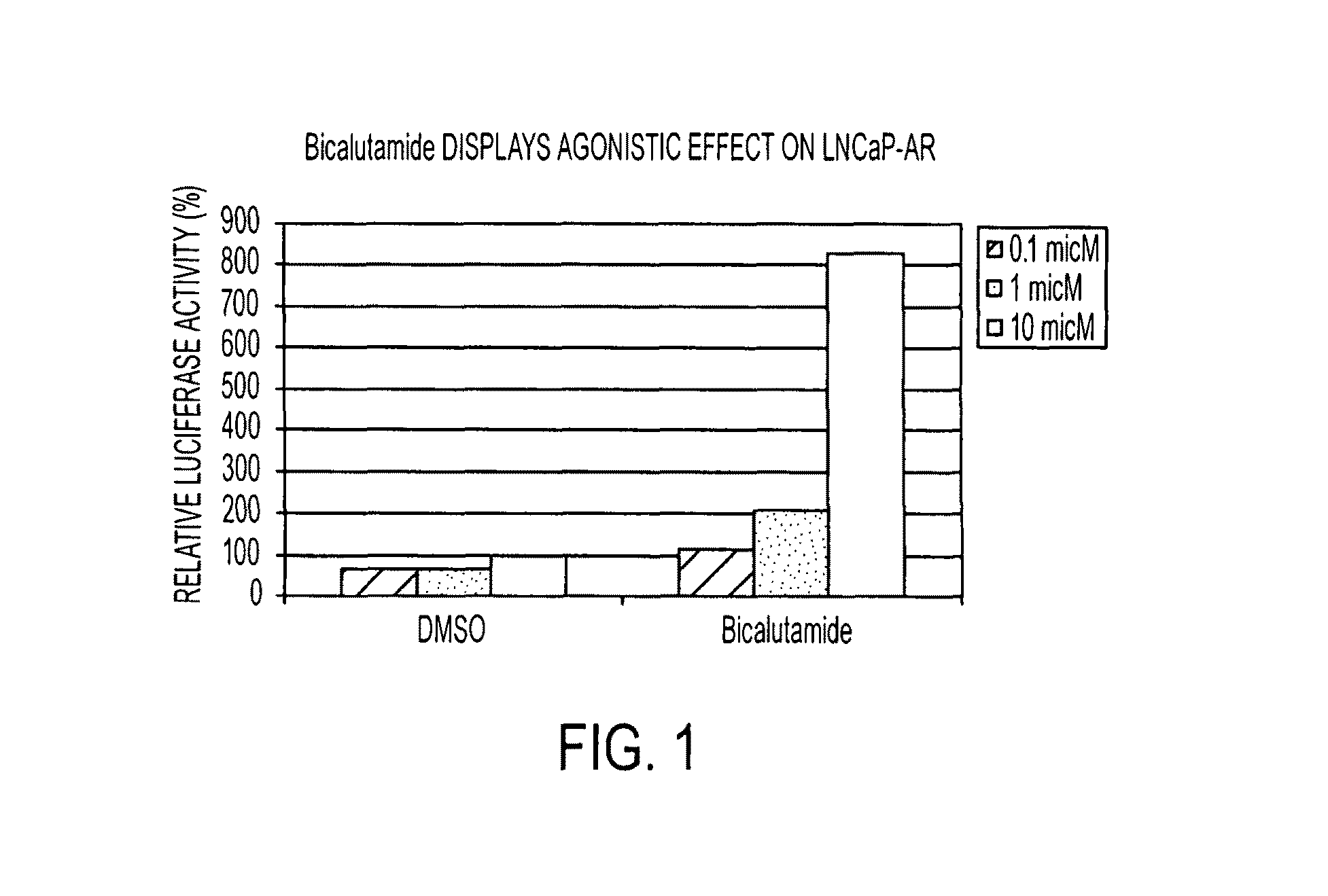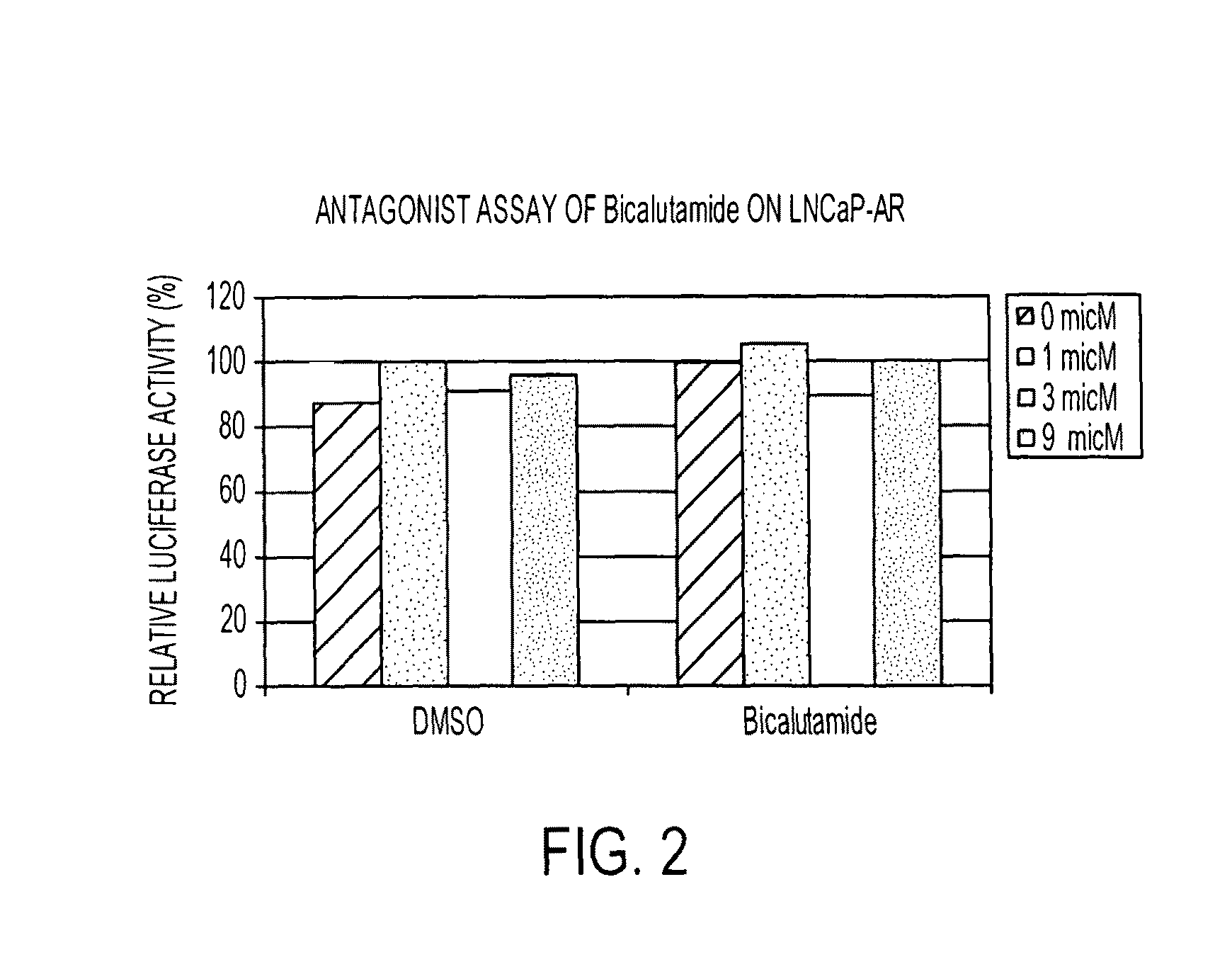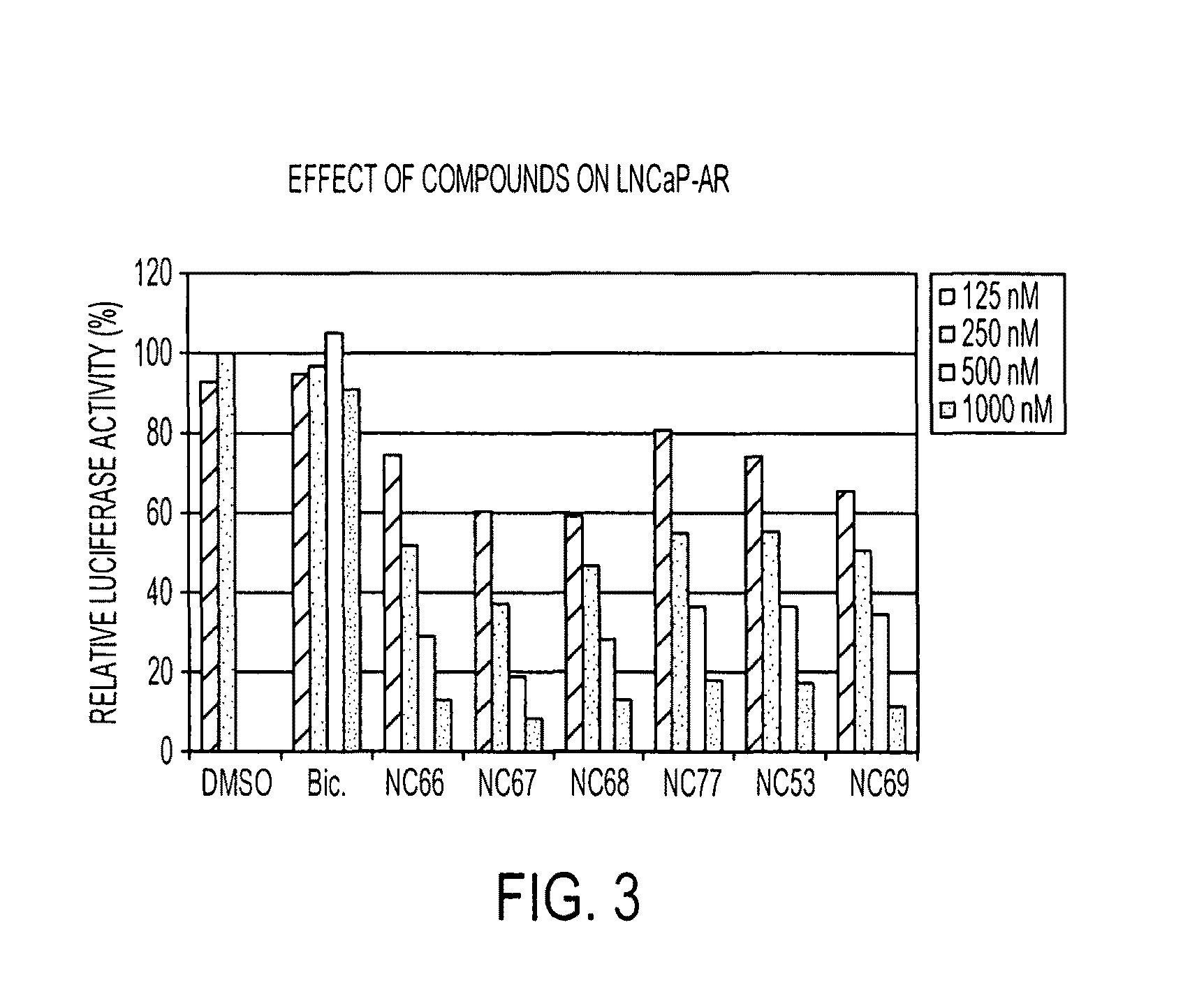Diarylthiohydantoin compounds
a technology of diaryl thiohydantoin and compound, which is applied in the field of diaryl thiohydantoin compounds, can solve the problems of not being able not being able to suppress ar when cancer becomes hormone refractory, and being unable to readily envision other specific compounds, so as to prevent the formation of a transcription complex, prevent the recruitment of androgen receptors, and prevent the nuclear translocation of androgen receptor
- Summary
- Abstract
- Description
- Claims
- Application Information
AI Technical Summary
Benefits of technology
Problems solved by technology
Method used
Image
Examples
example 56
NC54
[0075]In the following, air or moisture sensitive reactions were conducted under argon atmosphere using oven-dried glassware and standard syringe / septa techniques. The reactions were monitored with a SiO2 TLC plate under UV light (254 nm) followed by visualization with a p-anisaldehyde or ninhydrin staining solution. Column chromatography was performed on silica gel 60. 1H NMR spectra were measured at 400 MHz in CDCl3 unless stated otherwise and data were reported as follows in ppm (δ) from the internal standard (TMS, 0.0 ppm): chemical shift (multiplicity, integration, coupling constant in Hz.).
[0076]
[0077]Periodic acid (1.69 g, 7.41 mmol) was dissolved in acetonitrile (25 mL) by vigorous stirring, and then chromium trioxide (0.16 g, 1.60 mmol) was dissolved into the solution. 2-Fluoro-4-nitrotoluene (0.33 g, 2.13 mmol) was added to the above solution with stirring. A white precipitate formed immediately with exothermic reaction. After 1 h of stirring, the supernatant liquid of...
example 57
[0088]
[0089]A mixture of N-Methyl-2-fluoro-4-aminobenzamide (Formula 39) (62 mg, 0.37 mmol), cyclopentanone (0.07 mL, 0.74 mmol) and TMSCN (0.1 mL, 0.74 mmol) was heated to 80° C. and stirred for 13 h. To the medium was added ethyl acetate (2×20 mL) and then washed with water (2×20 mL). The organic layer was dried over MgSO4 and concentrated and the residue was purified with silica gel column chromatography (dichloromethane:acetone, 95:5) to give N-Methyl 2-fluoro-4-(1-cyanocyclopentyl)aminobenzamide (Formula 43) (61 mg, 63%) as a white solid. 1H NMR δ 7.95 (dd, 1H, J=8.8, 8.8 Hz), 6.65 (br s, 1H), 6.59 (dd, 1H, J=8.8, 2.3 Hz), 6.50 (dd, 1H, J=14.6, 2.3 Hz), 4.60 (br s, 1H), 2.99 (dd, 3H, J=4.8, 1.1 Hz), 2.36-2.45 (m, 2H), 2.10-2.18 (m, 2H), 1.82-1.95 (m, 4H).
[0090]
[0091]A mixture of N-Methyl 2-fluoro-4-(1-cyanocyclopentyl)aminobenzamide (Formula 43) (57 mg, 0.22 mmol) and 4-isothiocyanato-2-trifluoromethyl benzonitrile (0.15 g, 0.65 mmol) in DMF (3 mL) was heated under microwave ir...
example 58
[0092]
[0093]Trifluoroacetic anhydride (0.85 mL, 6.14 mmol) was added to a solution of 4-(4-aminophenyl)butyric acid (0.5 g, 2.79 mmol) in chloroform (10 mL) at 0° C. The mixture was warmed to room temperature and stirred for 3 hours. The mixture was partitioned with chloroform (20 mL) and water (20 mL). The organic layer was dried over MgSO4, concentrated and the residue was purified with silica gel column chromatography (dichloromethane:acetone, 9:1) to give 4-[4-(2,2,2-Trifluoroacetylamino)phenyl]butanoic acid (Formula 45) (0.53 g, 69%). 1H NMR δ 7.81 (br s, 1H), 7.48 (d, 2H, J=8.5 Hz), 7.22 (d, 2H, J=8.5 Hz), 2.68 (t, 2H, J=7.5 Hz), 2.38 (t, 2H, J=7.5 Hz), 1.96 (p, 2H, J=7.5 Hz),
[0094]
[0095]Thionyl chloride (71 mg, 0.60 mmol) was added slowly to a solution of 4-[4-(2,2,2-Trifluoroacetylamino)phenyl]butanoic acid (Formula 45) (0.15 g, 0.55 mmol) in DMF (5 mL) cooled at −5° C. The mixture was stirred for an additional 1 hour at −5° C. Excess dimethylamine (freshly distilled from it...
PUM
 Login to View More
Login to View More Abstract
Description
Claims
Application Information
 Login to View More
Login to View More - R&D
- Intellectual Property
- Life Sciences
- Materials
- Tech Scout
- Unparalleled Data Quality
- Higher Quality Content
- 60% Fewer Hallucinations
Browse by: Latest US Patents, China's latest patents, Technical Efficacy Thesaurus, Application Domain, Technology Topic, Popular Technical Reports.
© 2025 PatSnap. All rights reserved.Legal|Privacy policy|Modern Slavery Act Transparency Statement|Sitemap|About US| Contact US: help@patsnap.com



